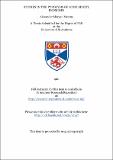Files in this item
Studies in the pyrolysis of some benzyl bromides
Item metadata
| dc.contributor.advisor | Horrex, Charles | |
| dc.contributor.author | Mearns, Alexander H. | |
| dc.coverage.spatial | 179 p. | en_US |
| dc.date.accessioned | 2018-07-09T15:43:16Z | |
| dc.date.available | 2018-07-09T15:43:16Z | |
| dc.date.issued | 1961 | |
| dc.identifier.uri | https://hdl.handle.net/10023/15147 | |
| dc.description.abstract | The work described in subsequent pages arose from certain difficulties in the current knowledge of the bond dissociation energies (D) of compounds of the type C₆H₅CH₂-X. For the reaction C₆H₅CH₂-X → C₆H₅CH₂ - + X – D k.cals. (1) we can write D(C₆H₅CH₂-X) = ΔHf(C₆H₅CH₂-) + ΔHf(X-) - ΔHf(C₆H₅CH₂-X) (2) where ΔHf is the heat of formation of a chemical entity. It has been the task of many recent researches to evaluate (D) for different compounds. Since the last two terms in the thermochemical equation are often known, a determination of D(C₆H₅CH₂-X) permits the heat of formation of the benzyl radical to be evaluated. It is obviously necessary that a consistent scheme should produce a single value for ΔHf(C₆H₅CH₂-) and one which is independent of the nature of X. Early work in this field by Szwarc had produced such agreement, but recent more detailed work, threw doubt on his findings for D(C₆H₅CH₂-H). Since his values were claimed to be cross-checked through (2), it was clear that his work on the determination of D(C₆H₅CH₂-H). Since his values were claimed to be cross-checked through (2), it was clear that his work on the determination of D (C₆H₅CH₂-Br)⁴ might also be in error, for it was claimed to agree with his toluene results. The pyrolysis of bromides in the presence of excess toluene has been the main kinetic practised by Szwarc, and benzyl bromide is one of many bromides which have been investigated by him. In theory the method requires that the primary dissociation R – Br → R- + Br- (3) shall be followed by the inhibition of secondary processes by reactions R- + C₆H₅CH₃ → RH + C₆H₅CH₂- (4) Br- + C₆H₅Ch₃ → HBr + C₆H₅CH₂- (5) 2C₆H₅CH₂- → C₆H₅CH₂CH₂C₆H₅ (6) Swarc claimed that the method showed the decompositions to have a first order dependence on RBr concentration, and that the temperature dependence of the velocity constant followed an equation log₁₀k = log₁₀A – E/4.57T for the most extensively investigated cases. He laid stress on the fact that the values of A he obtained were close to 10¹³ sec⁻¹, which is the expected value for a first order reaction, and hence that he was observing the dissociation process (3). As usual in this field the energy of activation E was taken as the bond dissociation energy. Justification for this assumption will be considered in the next section. Benzyl bromide was one of the compounds Szwarc investigated more extensively and the results conformed with the above generalisations. In case of several other bromides the published results do not justify his assumption that the temperature independent factor would be found to have the value 10¹³ sec⁻¹ under a more exhaustive scrutiny. These items prompted a re-examination of the whole toluene carrier gas technique as applied to benzyl bromide. In one form of this technique, and probably the most widely used version, a stream of toluene vapour entrains the halide Rbr by passage over the surface of the latter. Although temperatures above the dew point of toluene were advocated by Szwarc, elementary considerations suggested that solution of toluene in the Rbr could not be prevented by this and uniformity of entrainment would suffer greatly. Varying concentrations of reactant would result and kinetic deductions would be invalidated. As described in later pages, some simple experiments showed this suspicion about the toluene carrier gas technique to be correct. In view of this end and the chemical uncertainties quoted earlier, there seemed a need to re-investigate the pyrolysis of benzyl bromide fairly extensively. In later pages the details of such work are given together with work on the chlorobenzyl bromides. Before dealing with the practical aspects of the work a short survey of the relevant previous investigations and kinetic techniques used is given. | en_US |
| dc.language.iso | en | en_US |
| dc.publisher | University of St Andrews | |
| dc.subject.lcc | QD341.B4M4 | |
| dc.subject.lcsh | Bromides | en |
| dc.title | Studies in the pyrolysis of some benzyl bromides | en_US |
| dc.type | Thesis | en_US |
| dc.contributor.sponsor | Carnegie Trust for the Universities of Scotland | en_US |
| dc.type.qualificationlevel | Doctoral | en_US |
| dc.type.qualificationname | PhD Doctor of Philosophy | en_US |
| dc.publisher.institution | The University of St Andrews | en_US |
This item appears in the following Collection(s)
Items in the St Andrews Research Repository are protected by copyright, with all rights reserved, unless otherwise indicated.

